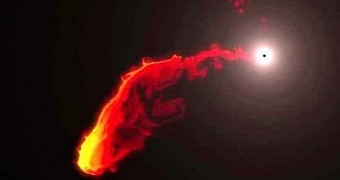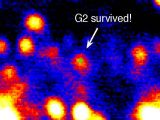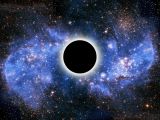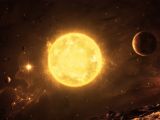Back in 2002, astronomers became aware of the presence of an odd celestial body in the proximity of Sagittarius A*, the black hole at the center of our home galaxy, the Milky Way. Come 2012, they eventually determined the object's orbit.
Based on this data, it was said that, sometime this year, the mysterious celestial body would get too close to the black hole for its own good and be devoured by it. However, recent data indicates that the bizarre object somehow escaped being devoured by Sagittarius A*.
A very close call
Scientists with the Lawrence Livermore National Laboratory in California, US, explain that, according to information at hand, it wasn't very long ago when the object, dubbed G2, came within 30 billion kilometers (some 18.6 billion miles) of the black hole.
However, rather than being drawn to it and ripped apart, it somehow managed to escape its gravitational pull and continued its journey through space. What's more, its close encounter with Sagittarius A* appears to have only disturbed it ever so slightly.
Thus, the Lawrence Livermore National Laboratory scientists claim that, although some of the gas comprising G2 was somewhat ruffled by the black hole, the celestial body itself remained pretty much intact. Seeing how G2 has long been believed to be a cloud of gas and dust, this came as a surprise.
A massive star in disguise
Looking to explain G2's survival when approaching Sagittarius A*, scientists argue that, all things considered, it could be that this supposed massive cloud of gas and dust hanging about our home galaxy might not merely a cloud after all.
On the contrary, they argue that it could be that G2 is actually a ginormous star cloaked in gas and dust. The temperature of the dust obscuring this presumed star from sight is one of about 550 degrees Kelvin (about 280 degrees Celsius / 530 degrees Fahrenheit).
The gas that comprises G2, on the other hand, is estimated to have a temperature of roughly 10,000 degrees Kelvin (roughly 9,700 degrees Celsius / 17,500 degrees Fahrenheit). Just to put things into perspective, it need be said that this makes it about twice as hot as the Sun.
As explained by the Lawrence Livermore National Laboratory researchers behind this investigation, having a star hidden under all this freakishly hot dust and gas could explain why it was that, rather than being torn apart by the black hole, G2 simply passed by it.
“The mass of the gas cloud by itself is far too small to hold the cloud together. If there were nothing else there, the cloud would have been torn apart, as indicated by our models and those of other researchers,” researcher Stephen Murray said in a statement.
“A star being present within the cloud would make sense, and was suggested by earlier workers trying to explain the origin of the G2 cloud, which is otherwise pretty mysterious,” the astrophysicist went on to explain, as cited by Phys Org.
Interestingly enough, evidence at hand indicates that the massive star at the core of G2 isn't just any other star. On the contrary, astronomers suspect that it was born when two stars that used to form a binary system merged with one another.

 14 DAY TRIAL //
14 DAY TRIAL // 



